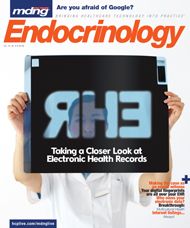Publication
Article
MDNG Endocrinology
LETTER from PUBLISHER: Will healthcare go mobile in 2010?
Author(s):
Healthcare providers’ perceptions of smartphones are changing. No longer viewed as an accessory that has limited utility in medical practice, smartphones are now viewed by many providers as must-have clinical tools, thanks to an explosion in the number of useful and affordable apps and a new generation of high-powered phones. The key to this shift is that smartphones are no longer mere add-ons—they are viable replacements for current computers. Henry J. Feldman, MD, chief information architect at Beth Israel Deaconess Medical Center in Boston, recently told HealthLeaders Media that BIDMC is no longer using smartphones merely as reference devices; they are using them as computer replacements. With powerful new smartphones, Feldman says he can do all the things that he normally does on a desktop during “a walk down the hall with another physician.” As Feldman says, “That is a fundamental shift.” Skeptical physicians can be forgiven for their reluctance to toss their desktop and go completely mobile. After all, we’ve been down this road before with the earlier generation of handheld computers and promises of a point-of-care revolution. The difference between then and now, though, is that earlier generations of hardware and software were incapable of replacing the power and functionality of a desktop. The technology simply wasn’t mature enough at the time. But now, thanks to vast expansions in processor and networking speed, the technology is capable of matching the hype. Currently, smartphones are most often used to run physician-centric apps—drug databases, calculators, references and other decisionsupport tools, etc, but that is changing rapidly. The next big thing to watch for is for more patients to incorporate smartphones into their health management strategies. I’m not talking about pill alarms and pedometers; I’m talking about transformative smartphone apps that allow for remote monitoring and reporting of patients’ health, integrated personal health records, and other connective tools that are designed to engage physicians, patients, and other stakeholders in a truly participatory healthcare exchange. To be sure, there are still many technical issues to resolve—privacy and security concerns foremost among them, but also screen size and usability, wireless coverage, and interoperability, to name a few. And, as always, there is concern about physicians becoming overwhelmed by too much information in an environment in which patients are in closer contact with their physicians than ever. But, as the cost of entry dwindles, more physicians are fi nding out fi rsthand just how useful smartphones can be in practice. From imaging, video, and stand-alone electronic record systems and other apps that enhance the clinical experience, providers are discovering that they may fi nally have a technology tool that helps more than it hinders. But don’t take my word for it; go to the Apple App Store (or the Microsoft or BlackBerry equivalent), read what other physicians have to say about some popular apps, and dive in (while you’re at it, go to www.hcplive. com/iphone and download our HCPLive To Go app, too). Then, e-mail us at ccole@mdng.com and share your opinions about how you and your colleagues can go mobile in 2010.
Thank you for reading.
Mike Hennessy






